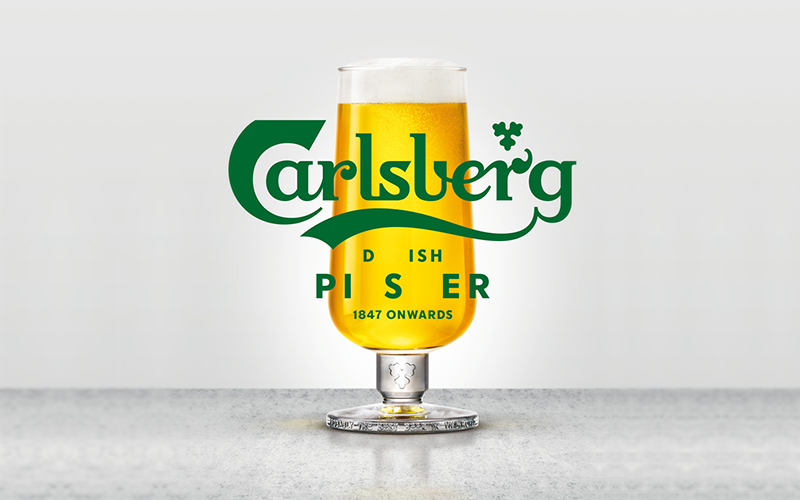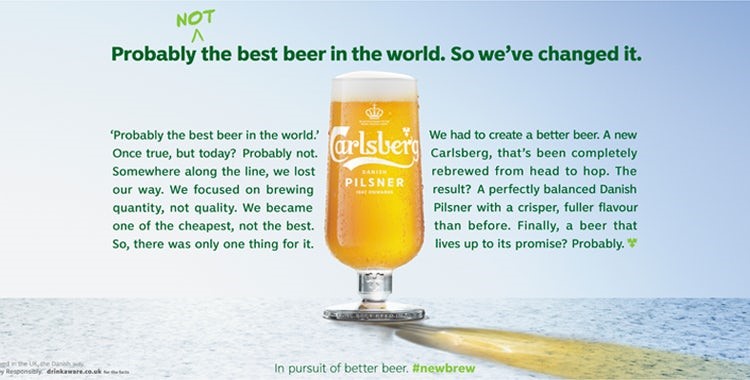
I think Carlsberg have just had a ‘Ratner moment’. Probably not the best marketing move in the world. You remember Gerald Ratner; the man who destroyed his multi-million pound jewellery empire in 10 seconds. He told a large gathering of business people and journalists that Ratner’s amazing prices were easy to explain. It was because the products were “total crap”. The rest as they say is history (no, I don’t think you have seen a Ratner jewellery shop lately have you?)
So Carlsberg has a dilemma. Forty years ago most beer in Britain truly was ‘total crap’. You had very few choices. The market was dominated by an oligarchy of brewers who had long forgotten about the actual craft of brewing. Beer was sent to brewery-owned pubs in metal kegs, chemically filtered, pasteurised and rendered lifeless under a blanket of carbon dioxide to make sure it stayed that way. Once at the pub, more CO2 was used to send the chilled product to the bar. Both lager and bitter got the same treatment meaning it was often difficult to tell the difference between them – colour was often the only clue.
You could say that beers of the time were (like their American cousins Coors Lite, Miller Lite, Bud Lite et al) a triumph of marketing over substance. My favourite game in American bars is first asking what beers they have, receiving the’ X,Y,Z Lite’ routine, and then asking the bar tender what the difference is. In dozens of times, I have never had an answer which strays far from “No-one’s ever asked before, I don’t’ know – not much”. The correct answer of course is “Marketing”.
The consumer’s eventual response to the ghastly brews of the seventies was CAMRA - the campaign for real ale. Often derided for a rose-tinted view of the past, they actually epitomise a grass-roots movement in reaction to producers that no longer cared about the product they made. CAMRA promoted a return to characterful, cloudy, soapy glasses of ‘Old Buttfuttock’ that nevertheless were gently carbonated (like Champagne) by a secondary fermentation in the (often) wooden cask, brewed with passion and served with pride. There are now over 1,500 breweries in the UK producing real ale, and countless others making craft beers that find their way into bottles and cans. The variety and choice is wonderfully vast.
It was into the beer desert of the seventies though that modern ‘British’ keg-based Carlsberg was born. In 1973 KMP agency were commissioned to come up with a catchphrase for it. In an earlier time (when for instance cigarettes were promoted on their health benefits) the more extravagant claim they came up with might have stuck: “The best beer in the world”. But this was not long after the arrival of the Advertising Standards Authority and their mantra that ads had to be “legal, honest, decent and truthful”. In a wonderful reflection of the Brits’ love of irony and the tongue-in-cheek, at the last minute the slogan was changed to “Probably the best beer in the world”. It was as though the British public were in on the idea that the ‘probably’ was added by some faceless quango now interfering in what you could say about your product (which of course they were and increasingly are).
Since then, to quote Guinness’ recently revised tagline – beer is now “Made of more”. More hops, more passion for the craft, more local content and lots of charismatic micro-brewery brands. Drinkers have a better choice of lots of much better beers. Unsurprisingly, in this general ‘premiumising’ of the market, it is the bland bottom end that has suffered. Carlsberg, Carling and Fosters all occupied this space (bear in mind that to confuse things, the bland version of Carlsberg sold in Britain is a ‘special brew’ for the UK. The product sold under the same name in most of Europe is generally a much better quality).
Unsurprisingly it is this sector and these brands that have been losing out in the last couple of decades. So what’s a brand manager to do? Sky-high awareness but declining category and brand sales, low attainable pricing and very poor brand consideration. Well probably not what Carlsberg UK have done.

So Carlsberg is re-positioning the brand with ads admitting it isn’t the ‘Best beer in the world’ “any more”. Promoting regular Carlsberg (they had already launched a premium Carlsberg Export a year ago) from cheap and cheeky to the “affordable standard plus” category containing American soda pop brands Coors Light and Bud Light.
But do Carlsberg even really understand where they have been? Rather than understand, a bit of revisionist history seems to be their preference. Their UK marketing director says that “We’ve been saying we’re ‘probably the best beer in the world’ since 1973, the issue is recently we’ve not been living up to that.” The ad above says: “Once true, but today? Probably not”
But there’s a major problem with that analysis – no-one ever took the claim seriously – presumably least of all Carlsberg. Their irony has been tickling beer drinkers since 1973. So what are they saying now? – “We were once probably the best beer in the world – but we’re not now.” Did no-one at Carlsberg or their agency say: “That statement is a contradiction of reasoning. The joke was, you couldn’t prove it then – how can they disprove it now?
This is a basic failure to understand the history of the brand’s own narrative by the people who should be best placed to understand it. Advertising that generated one of the UK’s best-loved slogans of all time – pushing the brand to the highest levels of awareness possible – is now disowned in some kind of hand-wringing act of self-shaming so loved by today’s authenticity and purpose-besotted marketers. Every time someone (people are still at it) parodied the ‘Probably the best’ pun they were aiding recall for Carlsberg!
The issue for Carlsberg is not that they have failed to live up to their promise “recently” - they never have (but it’s OK because no-one took it seriously) - but that they have been replaced in drinker’s affections by much better products. This ‘recently failed, no longer the best’ is simply fake news. It is simply beyond me why they came up with it – and even worse – presumably because they believed it, have built a strategy on it. Believe me if you make a mistake about where you are (brand orientation) you will certainly never be able to determine where you are going or how to get there (brand strategy).
And then – just when you couldn’t believe it could get any worse – it did. But unlike Gerald Ratner, the ‘crap’ is replaced by variations on a ‘piss’ theme.
Yes Carlsberg promoted customer tweets that likened Carlsberg to for example camel’s piss, a urinal cube and a bitter divorce. Yes, let me say that again, Carlsberg used their own money to denigrate their own brand like that. Even Gillette only used their own money to denigrate their customers with their toxic masculinity campaign, not the product.
So now an improved version of regular Carlsberg is on the way. Inspired by a new purpose statement (of course): “Pursuit of better beer”.
Carlsberg already had a big problem. I don’t think it’s going to go away.
But I’m not going to leave it at that. I think Carlsberg have done the wrong thing wrong. So what might Pull have done if Carlsberg came to us? Well funnily enough we would have looked at brand purpose, we would have done everything we could to uncover the brand’s provenance as well. We would also delved deep into the category and sub-category data and dynamics. We would challenge the brand to do research to gain new insights about how consumers feel about the brand, and in particular how seriously they take the “Probably best” claim, and how it might resonate in different brand circumstances.
I’m pretty sure too that we would come up with a better mission/purpose statement (the difference between the two is mere wankpuffery). Carlsberg’s purpose statement could be used interchangeably by any beer brand that exists. If there isn’t something unique about a brand’s purpose, perhaps there shouldn’t be a brand.
And I’m serious. Whenever we work with a brand at Pull we first create a ‘Blueprint’. This has the effect of holding a brutally illuminated mirror up to the brand. I think if this process had been done properly at Carlsberg, it would have become clear that UK Carlsberg was in fact a brand anomaly that failed to reflect the Carlsberg brand values or storied past (Carlsberg practically invented lager). A long-lived anomaly that has lived too long.
Sometimes, when we can’t get a brand to sing at Pull, we know it is not the brand it’s the product. The UK keg lager drinkers’ Carlsberg is dull wishy-washy stuff (otherwise known to Carlsberg drinkers apparently as various forms of piss after all). It is in a declining category that is almost certainly difficult to make a profit in.
On the other hand, the one-year old Carlsberg Export is clearly a better product with good levels of consideration, and of course that stellar (no pun intended) brand awareness. So kill off the camel’s piss. Strategy is sometimes the art of sacrifice. But keep the slogan, and use if for Carlsberg Export.
Instead I fear that Carlsberg have told their drinkers that it used to be the best (not ever true), that they lost their way and forgot about quality (not true, they never found it), that drinkers think the current brand tastes like piss (The Ratner moment) but it’s going to be a bit better going forward. And presumably ditch the invaluable brand equity represented by their “Probably the best” slogan.
Somehow I think this isn’t going to work out well.
Posted 24 April 2019 by Chris Bullick